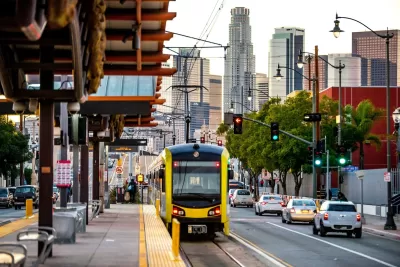Rail and bus ridership in the Los Angeles metropolitan area is recovering at a faster rate than the national average.

L.A. Metro averaged more than 1 million weekday riders for the first time since before the pandemic last month, according to an article from local news outlet KNX News. The milestone marks the 22nd consecutive month of year-over-year ridership growth. The announcement comes as transit ridership has lagged behind pre-pandemic levels in major cities across the country.
The article goes on to report that L.A. Metro’s combined bus and rail ridership reached 86.4 percent of its September 2019 pre-pandemic records, which exceeds the nationwide transit average of 76 percent of pre-pandemic levels. When divided between weekdays and weekends, Metro boardings stood at 83.6 percent and 96.9 percent of September 2019 levels respectively.
One of the driving factors in the sluggish ridership recovery is shifting work patterns (e.g., increase in remote work), as well as service cuts due to funding and staffing challenges. But all modes are not struggling, or recovering equally. According to a April article from Smart Cities Dive, bus transit has recovered faster nationwide, having reached 81 percent of 2019 ridership as of December 2023, while commuter rail has lagged at 65 percent. According to the KNX News article, L.A. Metro is bucking that trend, with commuter rail boardings increasing 10 percent in September 2024 compared to September 2023 versus 6.9 percent for bus boardings.
FULL STORY: Metro reaches milestone of 1M weekday riders

Planetizen Federal Action Tracker
A weekly monitor of how Trump’s orders and actions are impacting planners and planning in America.

Congressman Proposes Bill to Rename DC Metro “Trump Train”
The Make Autorail Great Again Act would withhold federal funding to the system until the Washington Metropolitan Area Transit Authority (WMATA), rebrands as the Washington Metropolitan Authority for Greater Access (WMAGA).

The Simple Legislative Tool Transforming Vacant Downtowns
In California, Michigan and Georgia, an easy win is bringing dollars — and delight — back to city centers.

The States Losing Rural Delivery Rooms at an Alarming Pace
In some states, as few as 9% of rural hospitals still deliver babies. As a result, rising pre-term births, no adequate pre-term care and harrowing close calls are a growing reality.

The Small South Asian Republic Going all in on EVs
Thanks to one simple policy change less than five years ago, 65% of new cars in this Himalayan country are now electric.

DC Backpedals on Bike Lane Protection, Swaps Barriers for Paint
Citing aesthetic concerns, the city is removing the concrete barriers and flexposts that once separated Arizona Avenue cyclists from motor vehicles.
Urban Design for Planners 1: Software Tools
This six-course series explores essential urban design concepts using open source software and equips planners with the tools they need to participate fully in the urban design process.
Planning for Universal Design
Learn the tools for implementing Universal Design in planning regulations.
Smith Gee Studio
City of Charlotte
City of Camden Redevelopment Agency
City of Astoria
Transportation Research & Education Center (TREC) at Portland State University
US High Speed Rail Association
City of Camden Redevelopment Agency
Municipality of Princeton (NJ)





























